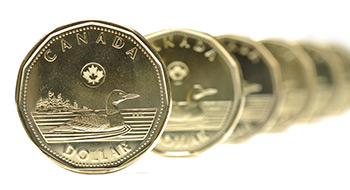
With another rate cut likely coming from the Bank of Canada and weak oil prices hurting economic growth and exports, the Canadian dollar is seen sliding to 77 cents U.S., finds a report from CIBC World Markets.
The central bank made a surprise 0.25-percentage point cut in its overnight lending rate last week.
“We’re adding a further 25-basis point cut to our forecast given the Bank of Canada’s evident impatience with respect to oil’s hit to growth,” says Avery Shenfeld, chief economist, CIBC World Markets, who is forecasting less than 2% economic growth in Canada this year. “While that second cut is priced in, markets may then guess about a third.”
Read: BoC to cut again: TD
He expects the Canadian dollar to decline to 77 cents U.S., three cents weaker than before last week’s rate announcement.
Pressure on the loonie will also come from rate hikes in the U.S. that will strengthen the greenback against other major currencies.
Shenfeld believes the U.S. Federal Reserve will hike interest rates in June, earlier than expected—and perhaps even higher than foreign-exchange markets now expect—given the pace of improvement in their labour market. “Evidence from prior tightening episodes suggests that policymakers don’t wait for wages to flash red before pulling the trigger on hikes,” he says.
“This is more than a rate-spread story. Oil isn’t the only commodity price that has softened. While non-energy export volumes will gain some support from a weaker Canadian dollar, manufacturing is now running at fairly tight capacity use rates, due to earlier plant closures. And, in nominal terms, exports will be crushed by the weakness in prices for oil, natural gas and other commodities.”
Read: Expect more surprises from BoC
“That will take the current account balance into sharply negative territory, miles below the consensus outlook that prevailed prior to oil’s nosedive,” Shenfeld says.
CIBC forecasts Canada’s current account deficit will balloon to over $70 billion in 2015, roughly twice the consensus forecast from a survey taken in June 2014.
The Bank of Canada was looking to see momentum in exports and capital spending before tightening the screws on household sector borrowing and homebuilding by raising rates. But, the collapse in crude oil prices, at least for 2015, defers that dream as the energy sector represents about a quarter of Canadian exports and nearly 30% of business spending, the report says.
Canadian consumers will save on gasoline, but the combined hit to industry and government revenues from the sharp decline in oil will slow Canada’s economic growth to less than 2% and leave the economy more dependent on household sector activity and non-energy exports, says Shenfeld.
Read: Bank of Canada lowers rate to 0.75%
He expects oil prices to start to recover by the end of the year and a reversal of the Bank of Canada’s rate cuts in 2016.
“That suggests a return to a firmer loonie,” Shenfeld says. “But even longer term, the need to have exports take the lead in growth from housing and debt-financed consumption points to a trading rate not far above 80 cents U.S.”
This story originally appeared on our sister site, <a href=”http://www.advisor.ca” target=”_blank”>Advisor.ca.
Also read:
